AI for Content Marketing Success: Tips, Tools and Opportunities
This guide shares everything to use AI for content marketing – from best practices and use cases, to smart prompts and tools that can generate everything from snappy ad copy to in-depth articles.
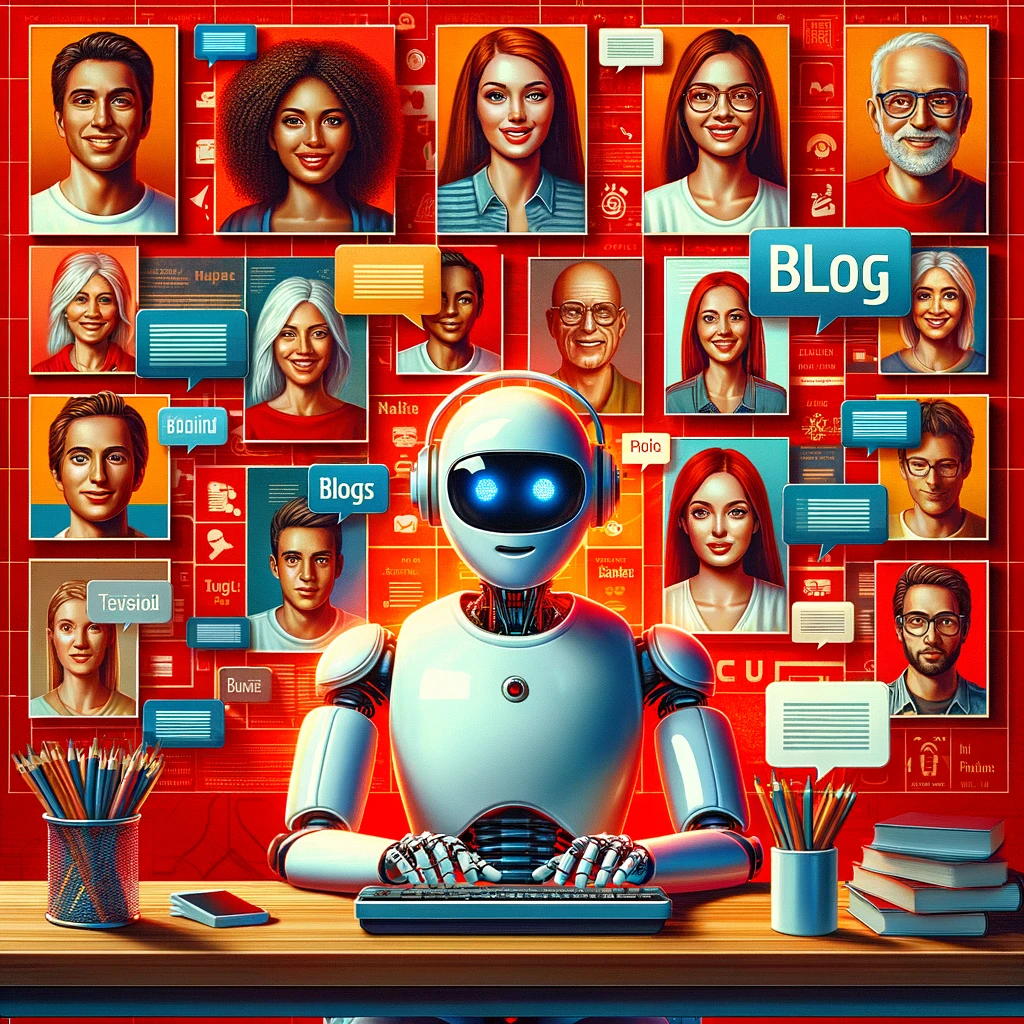
Table of Contents:
The rise of AI for content marketing is akin to the discovery of fire for early humans—a revolutionary tool that has the power to illuminate and challenge.
The big question looms: How do marketers balance the fine line between innovation and authenticity when it comes to harnessing AI?
Creating content that resonates with busy B2B audiences is a constant struggle. Every marketing team has felt the pressure to churn out fresh blog posts, new campaign messages, white papers, and social media content, often while battling limited resources and a nagging sense of “been there, done that.”
AI offers the promise of streamlining the content creation process, uncovering emerging trends with precision, scaling great content and optimizing for the algorithms of search engines – it’s not just a tool, but a much needed ally.
As marketers venture further into this AI-augmented landscape, it’s crucial to wield this powerful tool with care. In this comprehensive blog we’ll delve into the use cases and opportunities of AI driven content, cover the latest AI tools and prompts, unpack the limitations, and unveil best practices to ensure your AI-generated content sings, not stumbles.
B2B Content Marketing Challenges
B2B content marketing shines when it delivers valuable insights that resonate with your audiences. But creating that kind of magic can feel tricky in today’s content-saturated landscape. B2B marketers face several challenges:

Content Saturation: The first hurdle is navigating the sea of content. The digital world overflows with information, making it difficult to stand out. It’s not just about creating content; it’s about crafting content that’s unique, valuable, and cuts through the noise. Marketers must find innovative ways to grab attention.
Understanding your audience: B2B buyers are not a monolith. They are often a diverse group of decision-makers, each with their own needs and pain points. Imagine tailoring your message to resonate with each individual in a room full of executives, directors, and managers – that’s the challenge of understanding the B2B audience.
Content Creation & Consistency: Personalizing content for each individual adds another layer of complexity. Delivering the right message, to the right person, at the right time, requires complex data analysis and a deep understanding of the intricate B2B sales cycle.
Optimizing for search engines. B2B marketers must constantly adapt their content to stay ahead of evolving algorithms and ensure their work ranks well for relevant keywords. This dance requires balancing the technical aspects of SEO with the need to create content that is engaging and human-friendly.
Quantifying ROI: Unlike B2C marketing, where results might be more immediate, B2B sales cycles can be long and convoluted. This makes it difficult to directly link content marketing strategies to final sales, creating a challenge for budget allocation and strategic planning.
The rapid pace of new tools and tech: New tools and platforms emerge constantly, forcing B2B marketers to adapt and integrate these technologies into their existing strategies. It’s like trying to learn a new dance move every week while still keeping up with the music – a demanding task that requires agility and a willingness to learn.
Cohesive content strategy: This encompasses not just content creation, but also its distribution, promotion, and performance evaluation. Many B2B marketers struggle to align their content strategy with broader business goals, producing pieces of content that might be tactically sound but strategically disjointed.
While these challenges are significant, they are not insurmountable. By acknowledging these hurdles and exploring new AI solutions, B2B marketers can navigate the complexities of the digital landscape and achieve content marketing success.
Top
Use Cases for AI Content Marketing to Cut Through the Noise
Embracing AI-powered tools helps overcome many of these common hurdles to produce high quality and targeted content. This translates to attracting qualified leads, nurturing stronger brand relationships, and ultimately achieving your marketing goals.
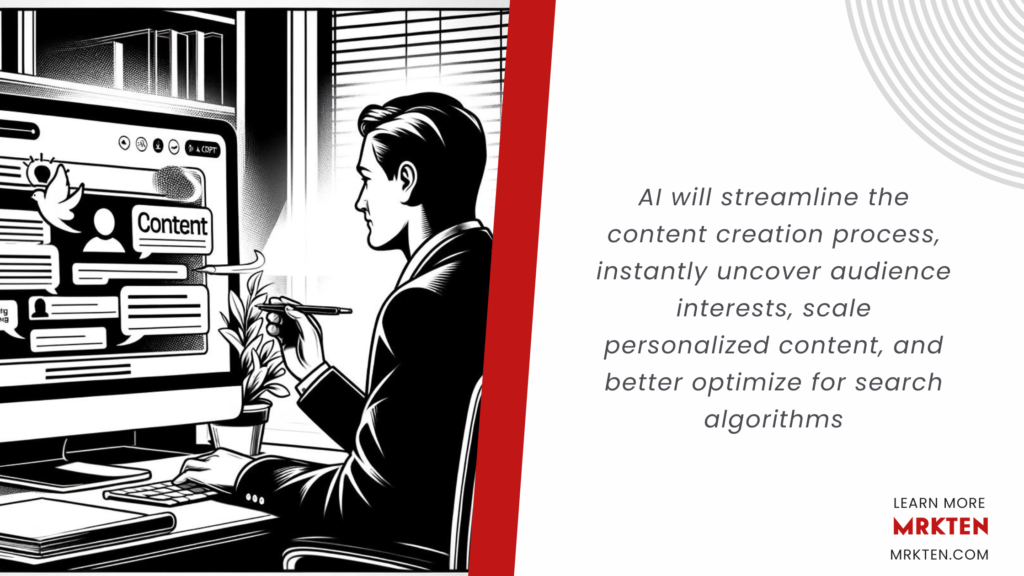
AI-driven insights can reveal content gaps in your niche so you can respond quicker to overcome content saturation. For example, AI-powered tools can more accurately analyze and interpret social media conversations, pinpointing trending topics and audience interests, allowing you to craft content that stands out and attracts organic traffic.
Example: Tools like Brand24 and SparkToro use artificial intelligence to analyze social media conversations to identify trending topics and audience interests, helping you create content that stands out.
Better understand your audience with audience segmentation tools to analyze customer reviews and social data to uncover hidden insights about your target audience, their pain points, and preferred content formats. This empowers you to craft targeted content that resonates deeply with specific buyer personas, leading to increased engagement and stronger brand relationships.
Example: Qualtrics is a tool to dive deep into customer reviews and social media data to understand buyer personas and their pain points, enabling you to craft targeted content that resonates.
Creating consistent, engaging content can be time-consuming – AI tools can accelerate content creation, even in your brand voices to generate product descriptions, blog outlines, and even first drafts based on your input, freeing up time for more strategic tasks.
Example tools like Writesonic can automate repetitive tasks like generating blog outlines, and even first drafts based on your input. This frees up valuable time to focus on strategy and creativity while ensuring consistent publishing and the ability to explore diverse content formats.
AI tools can optimize for search engines by taking the guesswork out of the equation. They analyze competitor content and suggest relevant keywords and optimization strategies to improve your search ranking, ultimately increasing your organic reach.
Example: SEMrush now features AI-driven SEO tools for keyword research, content optimization, and tracking search rankings.
AI-powered analytics tools can track and integrate key metrics like website traffic, lead generation, and engagement, providing clear insights into content performance and allowing you to demonstrate ROI and optimize your strategy for better results.
Example: PaveAI uses AI to attribute sales and conversions back to specific content pieces, clarifying content marketing ROI.
AI is a powerful content marketing tool when complimented by human marketers in the content marketing process. These are just a ways of how generative AI will enrich the full range of B2B content from blog topics, social posts, email subject lines or just inspire content ideation and creative ideas.
How to Use ChatGPT and Google Gemini to Power Your B2B Content Marketing
We explored how AI can support various aspects of B2B content marketing. Now, let’s see how two leading AI tools, ChatGPT and Google Gemini, can specifically contribute to each solution:
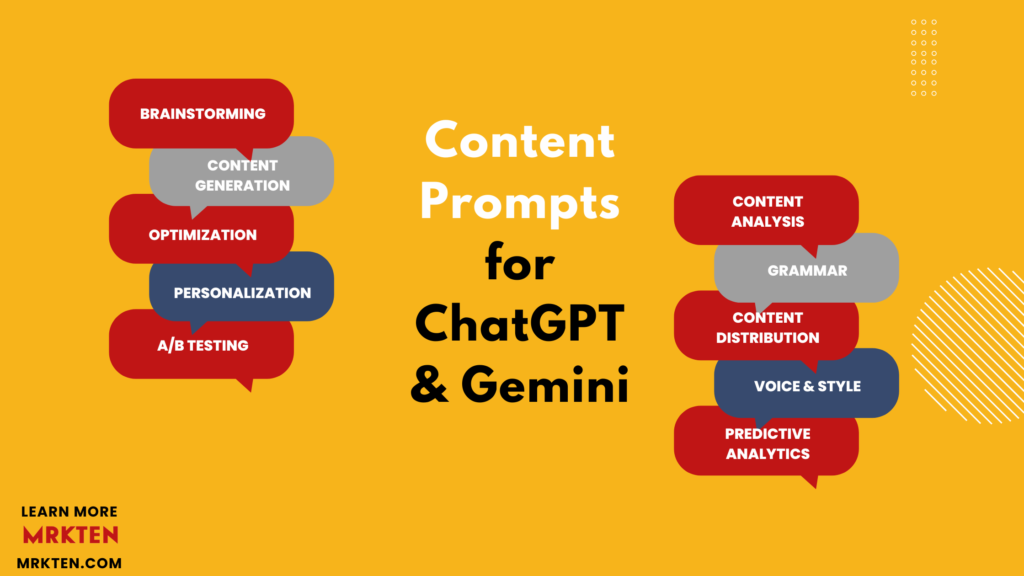
1. Content Brainstorming
ChatGPT can generate content ideas and outlines based on industry trends, keyword suggestions, or specific themes.
Prompt: “Generate a list of content ideas related to [describe trend] trends for [list year].”
Prompt: “Based on recent industry trends and a target audience of [describe target audience], suggest 5 content ideas related to [describe topic]”
Google Gemini: Can identify trending queries in your industry, then craft content that addresses these topics.
Prompt: “Generate a blog post outline exploring the challenges and opportunities of [describe topic]”
2. Content Generation
ChatGPT: Both tools can generate a range of different types of content from blog posts, social media to product descriptions and emails. Here a few to try.
Prompt: “Write a product description for a [describe product], highlighting its features and benefits for [describe target audience].”
Google Gemini:
Prompt: “Generate a social media post about [describe topic] for our upcoming webinar on [topic].”
3. Content Optimization
ChatGPT: Can offer suggestions for optimizing content, including keyword integration, readability improvements, and meta descriptions.
Prompt: “Optimize the following blog draft for SEO with a focus on the following topic [topic or keywords].”
Prompt: “Analyze this text and suggest improvements in clarity, conciseness, and flow [paste text]”
Google Gemini: Provide the same blog post. Gemini will analyze it, suggesting relevant keywords and optimization strategies to improve search engine ranking.
4. Personalization
ChatGPT can create personalized content drafts or messages tailored to different audience segment. Define your target audience (e.g., healthcare professionals) and provide some basic information about their needs and challenges to personalized your content’s tone and language to resonate better with specific audiences.
Prompt: “Draft a personalized email for [define target audience] who have these needs [describe audience needs] to highlighting [describe your products, features, promotions, benefits etc.]”
Google Gemini: While it can’t directly analyze user interaction data like ChatGPT, you can leverage its strength in search trend analysis to achieve similar results.
Prompt: “ Analyze trending search queries and user behavior data related to [enter industry] industry Based on your insights, identify potential audience segments with distinct content preferences. For each segment, predict the types of content topics that are likely to resonate with them based on search trends and user behavior patterns.”
5. A/B Testing
ChatGPT:
While ChatGPT doesn’t directly offer A/B testing capabilities, it can be used to generate variations of headlines or call-to-actions for you to test manually.
Prompt: “Generate 10 alternatives for headlines and calls to actions based on this text [text]”
6. Content Analysis
ChatGPT: Interpret analytics data to provide insights into content performance, suggesting improvements or new strategies.Provide existing content and ask ChatGPT to analyze the sentiment, identify potential areas for improvement, and suggest revisions to enhance clarity or engagement.
Prompt: “Analyze and summarize sentiment and suggested improvements based on this feedback [paste text]”
Prompt: “Analyze the following performance metrics and recommend ways to improve our content engagement.”
Google Gemini: Similar to ChatGPT, Gemini can analyze existing content, focusing on aspects like readability and SEO optimization, while offering suggestions for improvement.
7. Grammar and Style Checking
ChatGPT: Can identify basic grammatical errors and suggest improvements within the content you provide.
Prompt: “Review this text and rephrase for grammar, conciseness and flow [paste text]”
Google Gemini: Similar to ChatGPT, Gemini can identify grammatical errors and suggest potential stylistic improvements.
Prompt: “Analyze this text for grammatical errors, including punctuation mistakes, subject-verb agreement issues, and incorrect word usage. Additionally, suggest potential stylistic improvements for clarity, conciseness, and overall flow [enter text]”
8. High Engagement Chatbot Scripts
ChatGPT: Integrate into chatbot scripts to provide more natural, engaging, and helpful conversations with website visitors.
Prompt: “Create a chatbot script for visitors asking about product availability.”
Google Gemini: While not directly creating chatbot scripts, insights from Gemini regarding common queries can inform the development of more effective chatbot interactions.
9. Predictive Analytics
ChatGPT: Analyze patterns in content performance data provided to it, offering predictions on future content trends or themes.
Prompt: “Based on the following engagement data, predict which content topics will likely resonate with our audience next quarter.”
Google Gemini: Can be used to analyze large datasets to predict trends, though it’s more about leveraging Google’s broader analytics capabilities than Gemini alone.
Prompt: “Analyze the provided content performance data, including metrics and identify patterns and trends that correlate with high-performing content. Suggest potential reasons for content success and areas for improvement [paste data and metrics]”
10. Automated Content Distribution
ChatGPT: While not directly distributing content, it can generate platform-specific versions of content and suggest optimal times for posting based on industry standards.
Prompt: “Adapt the following article summary for LinkedIn and suggest when to post it for maximum engagement [text]”
Google Gemini: Similarly Gemini Insights on peak activity times and audience behavior can guide content distribution strategies
ChatGPT excels in generating and optimizing content, providing insights, and simulating engaging interactions. Google Gemini (and associated Google analytics and trend tools) can offer the data-driven backbone necessary for informed decision-making, from ideation through to performance analysis.
Remember, both tools are under continuous development, so their capabilities may evolve. By experimenting and exploring their functionalities, you can discover which tool best fits your specific needs and empowers your B2B content creation journey.
AI Tools to Spark Content: From Brainstorm to Brilliance
Keeping up to date on an ever growing list of AI tools is tough. To help we summarized the best use case among the most popular AI content creation tools for 2024. Remember, AI content creation tools are constantly evolving and improving. This list provides a starting point for your exploration, and the best tool for you will depend on your specific needs and preferences.
1. Jasper
- What it does: Creates long-form content like blog posts, articles, and landing pages, and also generates marketing materials like ad copy and social media posts.
- Best for: Content creation across various formats, marketing copywriting.
- Learn more: www.jasper.ai
2. Copy.ai
- What it does: Offers a wide range of templates for various content types, including social media posts, product descriptions and website copy.
- Best for: Short-form content creation, exploring different writing styles.
- Learn more: www.copy.ai
3. Writesonic
- What it does: Generates different kinds of content formats, including product descriptions, blog outlines, and even video scripts.
- Best for: Content brainstorming, exploring diverse content formats.
- Learn more: www.writesonic.com
4. Rytr
- What it does: Offers various content templates and long-form content generation capabilities, along with translation features.
- Best for: Content creation in different languages, exploring various content formats.
- Learn more: www.rytr.me
5. Simplified AI
- What it does: Offers quick and straightforward content generation for various marketing materials, including blog posts, ads, and website copy.
- Best for: Simple and fast content generation, basic marketing copywriting.
- Learn more: www.simplified.com
6. Canva
- What it does: Primarily a graphic design tool, Canva now offers an AI image generator that allows you to create images based on your description.
- Best for: Generating visuals to accompany your content, basic image creation based on text prompts.
- Learn more: www.canva.com
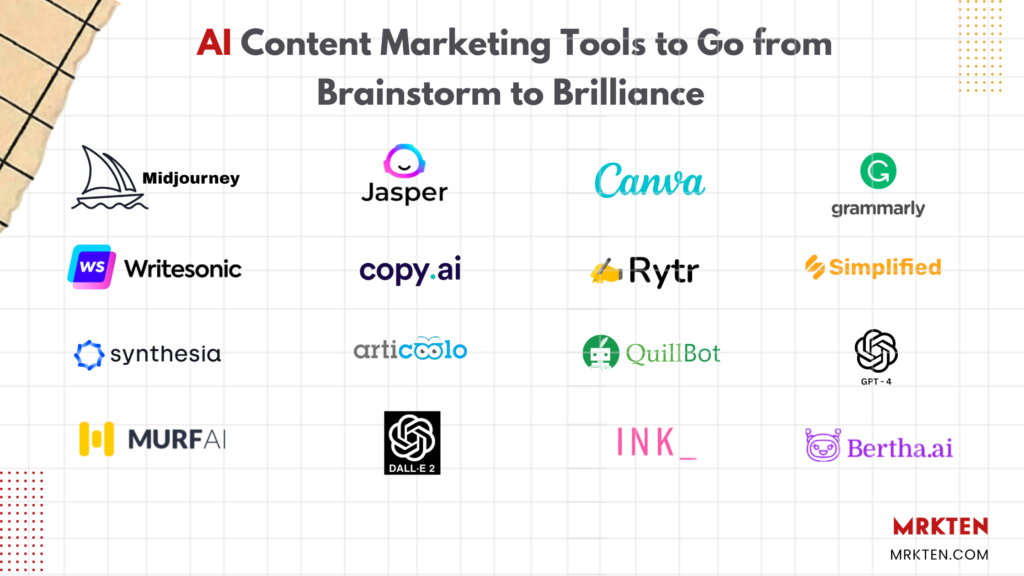
7. DALL-E 2
- What it does: A powerful AI image generation tool from OpenAI, capable of creating highly realistic and creative visuals.
- Best for: Creating unique and high-quality images for various purposes, including marketing materials and presentations.
- Learn more: www.openai.com/dall-e-2
8. Midjourney
- What it does: An independent AI image generation platform known for its artistic and creative outputs.
- Best for: Generating artistic and creative visuals for design projects and illustrations.
- Learn more: www.midjourney.com
9. Murf
- What it does: Specializes in AI-powered text-to-speech generation, allowing you to create realistic and engaging voiceovers for your videos and presentations.
- Best for: Adding professional voiceovers to your content, creating audio experiences.
- Learn more: www.murf.ai
10. Synthesia
- What it does: Generates realistic AI-powered videos featuring human avatars that can speak and deliver your message in various languages.
- Best for: Creating engaging video content without the need for actors or filming, personalized video communication.
- Learn more: www.synthesia.io
11. OpenAI’s GPT-4 (or its latest iteration)
- What it does: A state-of-the-art language model known for generating human-like text, capable of writing articles, answering questions, and more.
- Best for: Broad applications, including content writing, coding, and conversational AI.
- Learn more: www.openai.com/chatgpt
12. Grammarly
- What it does: More than just a grammar checker, it’s now integrated with AI to enhance writing clarity, tone, and effectiveness across various forms of written communication.
- Best for: Anyone needing to polish and refine their written content.
- Learn more: www.grammarly.com
13. Articoolo
- What it does: Generates unique, proofread, high-quality textual content from scratch, simulating a real human writer.
- Best for: Content creators needing quick drafts or ideas to develop further.
- Learn more: www.articoolo.com
14. QuillBot
- What it does: Focuses on paraphrasing and improving the quality of written text, with a strong AI-powered thesaurus to vary sentence structure and word choice.
- Best for: Academic writing, research, and anyone looking to improve the originality of their content.
- Learn more: www.quillbot.com
15. INK
- What it does: An AI-powered writing assistant designed for SEO, helping to optimize content for better search engine ranking.
- Best for: SEO specialists and content marketers focused on organic search visibility.
- Learn more: www.inkforall.com
16. Bertha.ai
- What it does: Specifically designed for WordPress users, Bertha helps create and optimize website content, including blog posts, product What it does:s, and more.
- Best for: WordPress website owners looking to enhance their site’s content efficiently.
- Learn more: www.bertha.ai
These tools represent the forefront of AI in content creation, offering solutions for a wide range of needs, from writing assistance to content optimization and beyond. Whether you’re a marketer, writer, or business owner, there’s likely an AI tool that can help streamline your content creation process.
What to Look for in AI-Powered Content Tools
Functionalities and strengths can greatly vary across AI-powered tools for content creation. Use the list below to prioritize whats important for your own team.
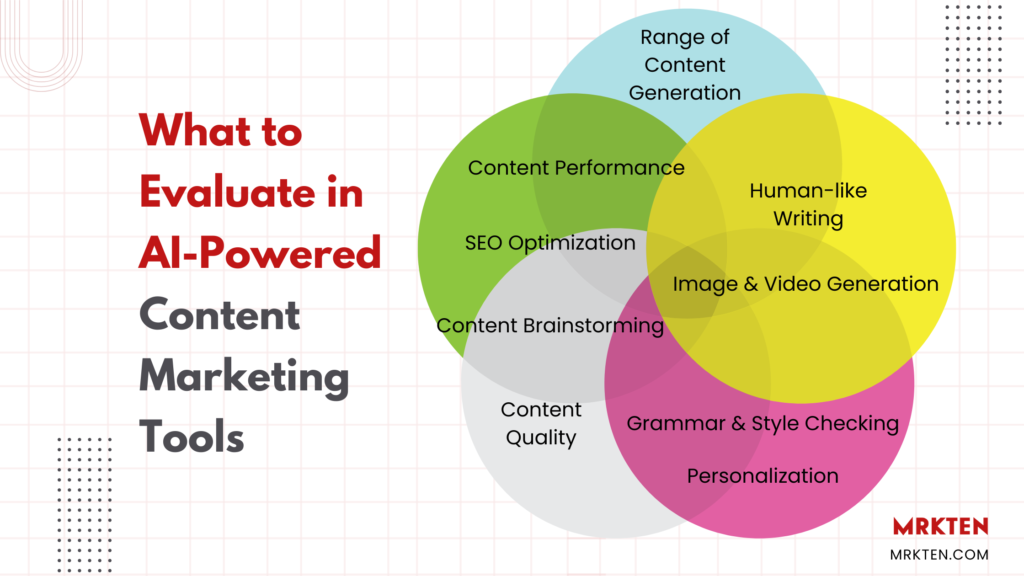
- Range of Content Generation: Ensure tools are optimized to generate the content formats you need like blog posts, articles, marketing copy, and even video scripts.
- Human-like Writing: Aim for tool that can generate text that closely mimics human writing, matches your brand voice and feels personal and engaging.
- Content Brainstorming: Some tools help you overcome writer’s block by suggesting content ideas and outlines based on trends and suited to your niche and target audience.
- SEO Optimization: IIdentify if the tool does not just create content but ensures it’s primed to rank well on search engines. They offer suggestions on keywords, readability, and other SEO factors, making your content more discoverable.
- Content Quality: Look for features that can analyze your content and suggest improvements for clarity, conciseness, clarity, tone, flow and originality.
- Personalization: Some tools allow you to tailor content based on user data, like demographics or past behavior, for a more personalized experience.
- Grammar & Style Checking: Several tools assist with grammar checks, stylistic suggestions, and ensuring your writing is polished and professional.
- Content Performance Analysis: Beyond creation, AI tools delve into how your content performs. They can analyze engagement and SEO effectiveness, offering insights that guide your future content strategy.
- Image & Video Generation: For visual content tools like Canva, DALL-E 2, and Midjourney offer AI-powered image generation, allowing you to create visuals based on your text descriptions.
Exploring these tools and their unique features can empower you to find the perfect AI companion to streamline your content creation process and elevate your B2B marketing efforts.
12 Best Practices for AI Content Creation
AI content creation tools are revolutionizing how we approach content marketing. However, maximizing their potential requires applying best practices to harness the full potential of AI-driven content creation. They offer a blend of efficiency, personalization, and insight that, when used wisely, can elevate your content strategy to new heights. Heres what to do.
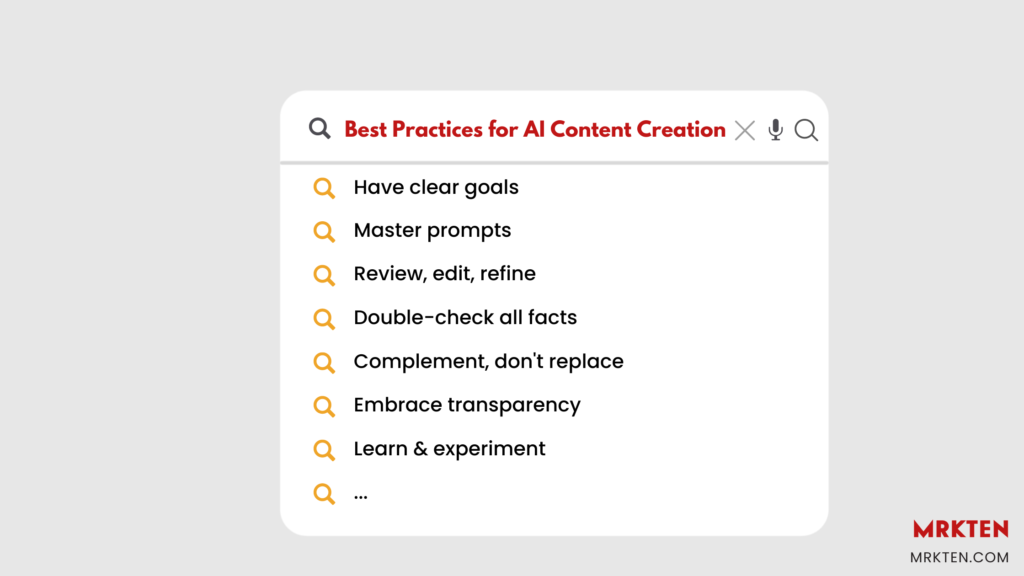
Define Your Goals: Be clear about your objectives with AI content creation. Whether it’s brand awareness, lead generation, or boosting website traffic, knowing your goals helps guide your AI tool usage. Your goal will guide how you use these tools.
Master Prompts: Crafting clear and detailed prompts is crucial for generating high-quality content. Be specific, provide context, and refine your prompts iteratively. AI tools work best when guided by detailed instructions. Provide clear, concise briefs with specific requirements to ensure the content meets your expectations.
Review, Edit and Refine: A human touch is crucial for authenticity. AI-generated content is a starting point, not a finished product. Meticulously edit, refine, and inject your unique voice and expertise to ensure exceptional quality. Always review and refine AI-generated content to ensure it aligns with your goals, maintains quality, and resonates with your audience.
Maintain Brand Consistency: Ensure the AI-generated content aligns with your brand voice, tone, and messaging. Maintain a consistent style for a seamless audience experience. Customize settings or inputs to reflect your brand’s style and tone, ensuring consistency.
Focus on Factual Accuracy: Double-check all facts and information generated by AI tools. Verify the accuracy and credibility of any data presented to avoid disseminating misinformation.
Embrace Transparency: Be transparent about using AI tools in your content creation process. Build trust with your audience by acknowledging your workflow – transparency fosters trust.
Prioritize Ethics: Be mindful of potential biases embedded in AI models. Avoid discriminatory or offensive content and strive for fair representation in your content.
Complement, Don’t Replace: AI tools are powerful allies, but they shouldn’t replace human creativity and expertise. Utilize them to enhance your content, not solely create it.
Keep Learning and Experimenting: AI is rapidly evolving. Continuously research and stay updated on the latest advancements and best practices for responsible AI content creation. Experimentation can lead to discovering powerful new ways to engage your audience and streamline your workflow.
Monitor SEO Trends: Leverage AI tools that offer SEO insights to stay ahead of search engine trends and algorithm changes. Incorporate suggested keywords and optimization tips to boost your content’s visibility.
Use AI for A/B Testing: Take advantage of AI tools to test different versions of your content to see what works best with your audience. This can include variations in headlines, calls to action, or content formats.
Diving into AI-driven content creation tools opens up a world of efficiency and innovation for creators across the board. By following these best practices, you can leverage AI tools effectively to streamline your content creation process, unleash your creativity, and achieve your marketing goals.
Limitations: A Powerful Ally, Not a Silver Bullet
It’s important to remember these AI tools are collaborators, not replacements for human creativity. While AI excels at tasks like content generation and data analysis, it has limitations that require a mindful approach – here are some key to consider:
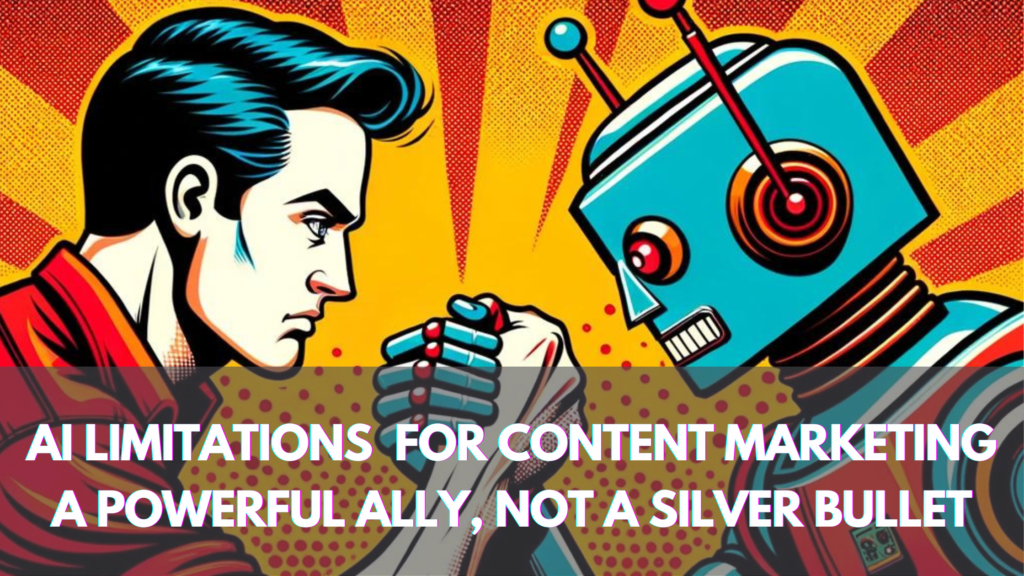
- Limited Creativity: AI struggles with truly groundbreaking ideas, often mimicking existing styles. It lacks the human touch that sparks original content.
- Accuracy and Bias: AI models can perpetuate biases present in their training data, leading to factual errors or misinterpretations. Careful fact-checking and awareness of potential bias are essential.
- Emotional Disconnect: AI lacks the emotional intelligence to understand and convey complex human emotions, potentially resulting in robotic or emotionally distant content.
- Lack of Context: AI might struggle with subtle nuances of language, humor, and cultural references, leading to misinterpretations or awkward phrasing.
- Long-Form Challenges: While AI is making strides, generating high-quality, long-form content like in-depth reports remains a hurdle for many tools.
- SEO Nuances: SEO optimization is complex and ever-evolving. AI tools might not fully grasp all ranking factors, potentially missing key elements.
- Keyword Stuffing: Overzealous keyword optimization can happen with AI, leading to unnatural content stuffed with keywords that hurt readability.
- Ethical Considerations: AI-generated content raises ethical concerns about potential misuse for creating fake news, plagiarism, or manipulating information. Responsible use is paramount.
- Dynamic Topics: Rapidly evolving topics or highly specific niches can challenge AI’s ability to adapt and generate accurate content.
- Cost and Accessibility: Advanced features in some AI tools can be expensive and limited by pricing tiers, potentially restricting access for smaller businesses.
By understanding these limitations, you can approach AI content creation with realistic expectations. AI excels at specific tasks, but human creativity and oversight are still crucial for effective content marketing. Used responsibly, AI can become a powerful ally, not a silver bullet, in your content creation journey.
Predictions & Trends for AI-Driven Content Creation
AI’s impact on content creation is unfolding rapidly. Although there is no way to predict the future here are some trends to pay attention and solutions for todays more limited AI tools.
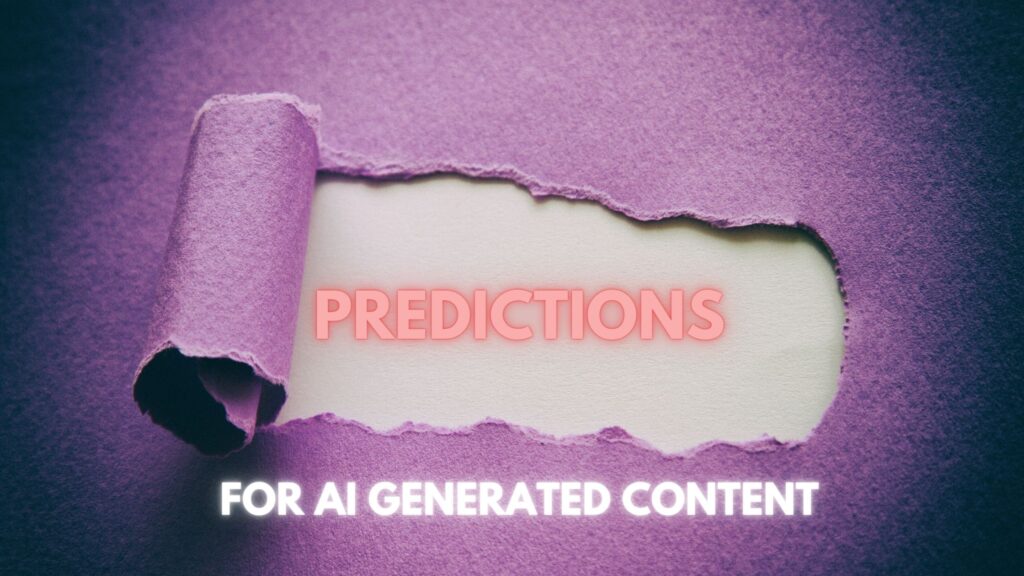
- Smarter Personalization: AI will ditch generic content for tailored experiences. Imagine blog posts that adjust to your reading habits or social media feeds that understand your interests.
- Accuracy and Trustworthiness: Expect AI to become a better fact-checker, ensuring content is reliable and ethical.
- Emotional Storytelling: AI is learning our language of emotions. Get ready for content that resonates with readers feelings, creating a deeper connection with brands and stories.
- Long-Form Done Right: AI will take over the heavy lifting of crafting lengthy reports and white papers, freeing up human minds for strategic thinking.
- SEO Mastery: AI will crack the code of search engines, optimizing content for discovery without sacrificing readability.
- Multimedia Explosion: AI will weave audio, video, and other elements into the content creation process, making it more engaging and interactive.
- Focus on You: By analyzing user behavior, AI will tailor content and experiences to keep you hooked.
- Transparency Takes Center Stage: Expect clear communication about AI’s role in content creation, building trust between humans and AI tools.
- AI for Everyone: AI-powered content creation tools will become more affordable and accessible, empowering businesses of all sizes.
- Responsible Rise of AI: As AI gets stronger, so will discussions on ethical considerations. This will ensure AI is used responsibly, avoiding bias and misinformation.
- The Future is a Collaboration: AI won’t replace human creativity; it will enhance it. Imagine AI as a partner, brainstorming ideas and crafting compelling content alongside humans.
This future holds immense potential for content creation. By embracing these trends and navigating them responsibly, we can unlock a world of effective, engaging, and informative content!
Key Takeaways AI-Driven Content Creation
AI’s is the most exciting tool for marketing. It’s moving at breakneck pace and marketers need to learn, try and adapt to stay ahead. This living guide will be constantly updated to reflect the bext practices,tools, prompts and use cases. But here some key takeaways:

- Know AI’s potential and limits: Let AI become a part of your content workflow to cut through the noise, better understand your audience interest, acclerate content creation, boost SEO and prove a return on investment. Keep in mind AI is constantly evolving, its not a pancia nor something to ignore. Rather keep your content transparent and ethical and keep up to date on its evolution and know what realistically to expect.
- Use best practices: Be crystal-clear about your goals —be it increasing traffic or leads—to steer your AI use. Select the right AI tool, one that not only fits your niche but also your wallet, and become a prompt pro, providing precise blueprints for content that hits the mark. Don’t forget the human touch; refine AI drafts to ensure they’re authentically you, factually sound, and ethically tuned, enhancing rather than replacing your creative spark.
- A prompt universe: Crafting good prompts is the difference between meh and marvelous. ChatGPT and Gemini can be versatile conversationalist, helping to craft witty social media posts that pop to being a grammar guru. It’s all about style and tone; whether you’re after breezy blog banter or formal report rhetoric, give it the right prompt, and voilà—consider your content tailored. Use them as your content assistant ready to color-match your content needs as needed.
- Know and use the right tool: Learn, try and use the variety of AI-powered content tools. Whether to spot content gaps and trends, like Brand24 or SparkToro to craft content that truly clicks with your crowd. Slice through the content creation grind with tools like Writesonic, using your own brand voice to write captivating blogs and sharp product copy, while SEMrush’s AI SEO whispers the keywords to get you noticed. And when it’s time to tally up your wins, PaveAI turns numbers into narratives to show how your content’s driving those all-important conversions.
⚡ Take Action, Next Steps
Join
Join our free expert newsletter for frequent tips, tools, prompts, and examples for marketers to do more with AI.
Try
Try an AI Masters Courses built by pro’s based on real world examples. Bite-sized engaging lessons to future proof marketing.
Access
Read another guide about AI for B2B Digital Marketing.
